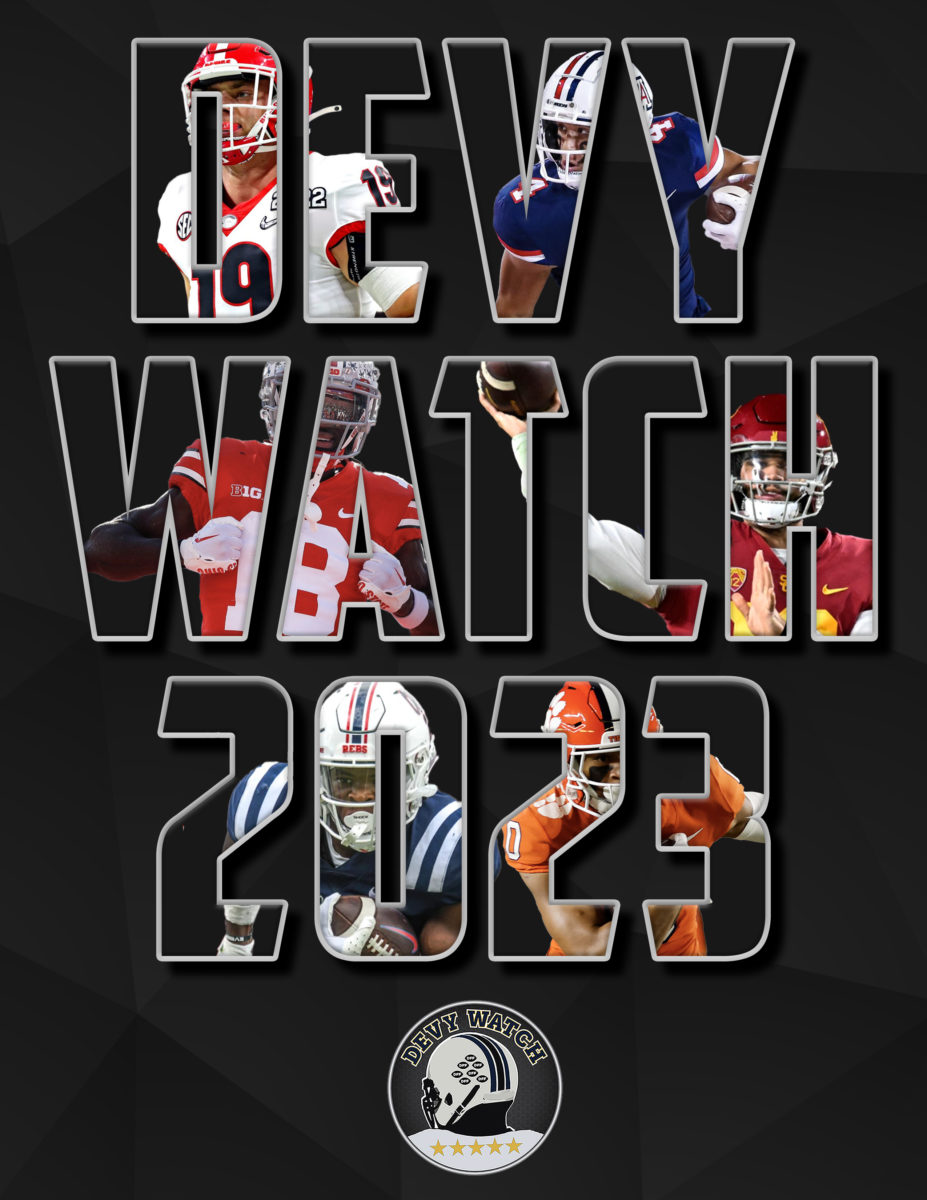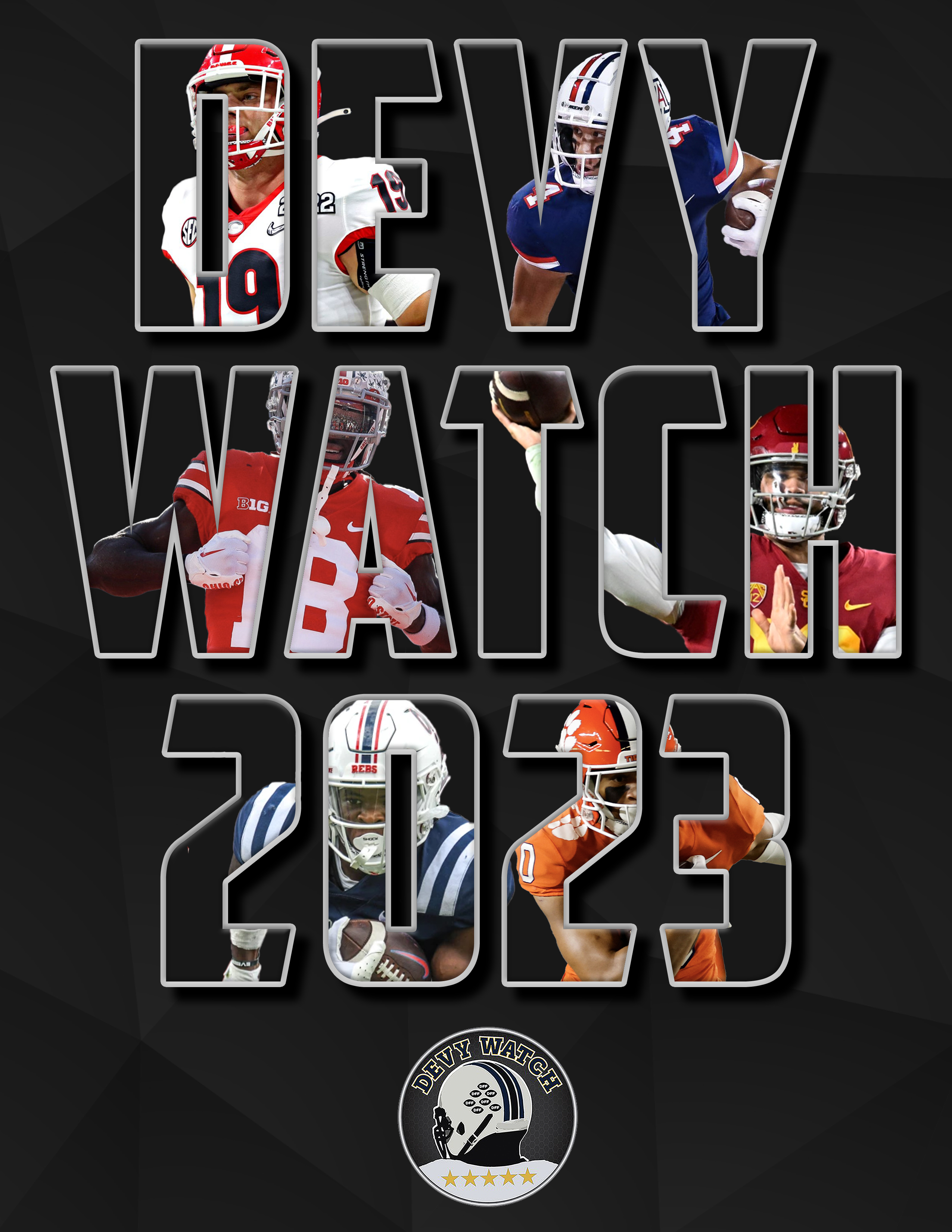Volume 2 of Devy Watch 2020 published over the weekend, and I thought it would be fun to take a by-the-numbers look to see if there were any trends to uncover. If you haven’t purchased your copy yet, you can grab it here. In addition to over 250 ranked players and profiles, Vacated Production, Breakout Age, Market Share, and Dominator Rating leaders, Volume 2 includes Projected Futures, an industry Superflex Mock Draft, and over 180 pages of college head coach and coordinator changes and how they’ll impact the college fantasy football landscape.
Top 25
The first thing I noticed was that eight of our top 25 were players who returned for their redshirt junior or senior seasons. I don’t know if the negative connotation that surrounds players returning to school is universal, but it didn’t affect too many players here. Even though we scratched our heads at some of the decisions, we know what we will get out of these eight in their final college football season.
Transfer Portal
When Volume 1 published back in February, there were several players still in the Transfer Portal. When Volume 2 published, only one of the 269 players that we ranked was still in the Transfer Portal. That was former Auburn RB JaTarvious Whitlow. Since the weekend, Alabama WR Tyrell Shavers announced his decision to transfer as well.
Positional Breakdown
QB – 13 of the 37 QBs are from the SEC – three less than the ACC (6), Big Ten (5), and BIG 12 (5) combined – thanks in part to three transfers and three promising tFR who haven’t taken a snap yet. We found four worthy QBs in the PAC-12, two from the Independents, one from the Group of 5, and our first-ever FCS QB.
RB – The SEC led all conferences with 22 of 90 total RBs. The SEC doesn’t have the same monopoly on the RB position as some of the others, but there’s definitely a trend developing here. The Big Ten wasn’t too far behind with 18. The ACC was third with 16. The rest:
PAC-12 – 13
BIG 12 – 10
Group of 5 – 8
Independents – 2
WR – 26% of the WRs in the Watch are from the Southeastern Conference (31 of 118). Thanks in part to Ohio State’s deepest position, the Big Ten had 24 of the 118 WRs. The ACC and BIG 12 were next with 19 and 16, respectively. Over one-third of the PAC-12’s 15 WRs call USC home. The G5 brought 10 WRs to the table, and Notre Dame represented the Independents with two.
TE – The Big Ten outnumbered the SEC seven to six, ruining the SEC’s clean sweep. The other 11 TEs that we ranked came from the ACC (3) and the BIG 12, PAC-12, Independents, and Group of 5 with two each.
Conference Breakdown
You don’t have to be good at math to figure out that the SEC was the superior conference (again this year) with 72 players. After a steep drop, the rest of the Power 5 conferences are somewhat bunched together. The Big Ten had 54 players, the ACC had 44, the PAC-12 had 34, and the BIG 12 had 33.
The American Athletic Conference has been calling themselves a Power 6 conference for years now, so it shouldn’t surprise anyone that they led all Group of 5 conferences with nine players in DW20. Memphis, Boise State, SMU, and Colorado State each have two players in the Watch. No G5 school had more than two players included this year. Even though the gap between the Power 5 and Group of 5 widens every April during the NFL Draft, we still found 21 total G5 players who we think will produce at the next level.
Breakdown by Team
Alabama, Georgia, and Ohio State tied for the most ranked players with 10. Clemson and USC each had nine representatives. LSU, Texas, and Texas A&M can each claim eight players worthy of making the 2020 Devy Watch. In a testament to what Mack Brown has done in Chapel Hill, the Tarheels have seven ranked players this year.
Other Trends
1. Before the Justyn Ross injury, Clemson had a QB, RB, and WR all ranked inside our top 15 overall. The uncertainty surrounding Ross’ injury nearly dropped him out of the top 100, but depth at WR is what Clemson does. tSO Joe Ngata was our WR14 and 27th overall before the injury and is our pick to scoop up the team’s WR1 production.
Dabo Swinney’s Tigers aren’t the only school with a highly-ranked trio of players. You can probably guess the other teams who can make that claim, but I’ll list them out for you:
Alabama (WR, RB, WR in top 23)
Auburn (WR, RB, QB in top 66)
Georgia (WR, QB, RB in top 29)
LSU (WR, WR, RB in top 48)
Ohio State (QB, WR, WR in top 28)
2. USC returns 5 WRs, all ranked in our top 75, with Amon-Ra St. Brown leading the way at WR9. Add tFR Gary Bryant, Jr., who I was really impressed by, and that’s six in the top 75. It makes sense that Kedon Slovis made a Volume 2 jump to QB6 (after Daniels’ transfer). Slovis has a terrific, even if somewhat unproven, supporting cast.
3. tFR QBs Bryce Young and D.J. Uiagalelei are ranked just outside of the top 50 as QB7 and QB8, respectively. From the same state, already playing twice a year and trading state championships before eventually competing for CFP championships, these two are going to be tied together for their entire college career…much like Trevor Lawrence and Justin Fields. Looking back to when Lawrence and Fields were tFR, we had them ranked as QB2 and QB3 overall before they ever took a snap.
4. There are several other young QBs who have promising supporting casts, but Arizona State went out of their way to put players around Jayden Daniels, so that he could be the best version of himself. Herm Edwards added a pair of contrasting running backs to the backfield as well as four WRs (two made the Watch) to Daniels’ receiving corps. Only Georgia had more true freshmen make the 2020 publication.










